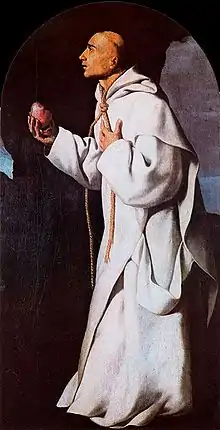John Houghton (martyr)
Saint John Houghton, O.Cart., (c. 1486 – 4 May 1535) was a Carthusian hermit and Catholic priest and the first English Catholic martyr to die as a result of the Act of Supremacy by King Henry VIII of England. He was also the first member of his order to die as a martyr. He is among the Forty Martyrs of England and Wales.[3]
John Houghton, O.Cart. | |
|---|---|
 St. John Houghton, O.Cart., by Francisco Zurbarán | |
| Forty Martyrs of England and Wales | |
| Born | c. 1487[1] Essex, England[2] |
| Died | 4 May 1535 Tyburn, England |
| Venerated in | Roman Catholic Church in England and Wales, Carthusian Order |
| Beatified | 9 December 1886 by Pope Leo XIII |
| Canonized | 25 October 1970 by Pope Paul VI |
| Feast | 25 October |
Life
Born around 1487, he was (according to one of his fellow Carthusians) educated at Cambridge, but cannot be identified among surviving records.[4] Similarly, no certain records can be found of his ordination.
He joined the London Charterhouse in 1516, progressed to be sacristan in 1523, and procurator in 1528.[1] In 1531, he became Prior of the Beauvale Priory in Nottinghamshire. However, in November of that year, he was elected Prior of the London house, to which he returned.[5] In addition, the following spring he was named Provincial Visitor, at the head of the English Carthusians.[1]
In April 1534, two royal agents visited the Charterhouse. Houghton advised them that "it pertained not to his vocation and calling nor to that of his subjects to meddle in or discuss the king's business, neither could they or ought they to do so, and that it did not concern him who the king wished to divorce or marry, so long as he was not asked for any opinion."[2] He asked that he and his community be exempted from the oath required under the new Act of Succession, which resulted in both him and his procurator, Humphrey Middlemore, being arrested and taken to the Tower of London. However, by the end of May, they had been persuaded that the oath was consistent with their Catholicism, with the clause "as far as the law of Christ allows" and they returned to the Charterhouse, where (in the presence of a large armed force) the whole community made the required professions.[2]
However, in 1535, the community was called upon to make the new oath as prescribed by the 1534 Act of Supremacy, which recognised Henry as the Supreme Head of the Church of England. Again, Houghton, this time accompanied by the heads of the other two English Carthusian houses (Robert Lawrence, Prior of Beauvale, and Augustine Webster, Prior of Axholme), pleaded for an exemption, but this time they were summarily arrested by Thomas Cromwell. They were called before a special commission in April 1535, and sentenced to death, along with Richard Reynolds, O.Ss.S., a monk from Syon Abbey.[5]
Houghton, along with the other two Carthusians, Fr. Reynolds, and Fr. John Haile of Isleworth, was hanged, drawn and quartered at Tyburn on 4 May 1535.[6]
The three priors were taken to Tyburn in their religious habits and were not previously laicised from the priesthood and religious state as was the custom of the day. From his prison cell in the Tower, Thomas More saw the three Carthusian priors being dragged to Tyburn on hurdles and exclaimed to his daughter: "Look, Meg! These blessed Fathers be now as cheerfully going to their deaths as bridegrooms to their marriage!" John Houghton was the first to be executed. After he was hanged, he was taken down alive, and the process of quartering him began.
Catholic tradition relates that when Houghton was about to be quartered, as the executioner tore open his chest to remove his heart, he prayed, "O Jesus, what wouldst thou do with my heart?" A painting of the Carthusian Protomartyr by the noted painter of religious figures, Francisco Zurbarán, depicts him with his heart in his hand and a noose around his neck. In the Chapter house of St. Hugh's Charterhouse, Parkminster, in England, there is a painting depicting the martyrdom of the three priors.
After his death, his body was chopped to pieces and hung in different parts of London. He was beatified on 9 December 1886 and canonized on 25 October 1970.
See also
References
- Hendriks, Lawrence. The London Charterhouse, London, Kegan Paul, Trench & Co., 1889
- Gasquet, Francis Aidan. Henry VIII and the English Monasteries, G. Bell, 1906, p. 60
 This article incorporates text from this source, which is in the public domain.
This article incorporates text from this source, which is in the public domain. - "St. John Houghton", FaithND
- "Houghton, John (HTN531J)". A Cambridge Alumni Database. University of Cambridge.
- Wainewright, John. "Blessed John Houghton." The Catholic Encyclopedia. Vol. 8. New York: Robert Appleton Company, 1910. 2 Feb. 2014
- Cranmer, Thomas (1833). The Remains of Thomas Cranmer, Archbishop of Canterbury. Oxford University Press.
Sources
- Oxford Dictionary of National Biography (2006)
- L. Hendriks, The London Charterhouse: its monks and its martyrs (1889)
- "Bl. Humphrey Middlemore". Catholic Encyclopedia.
![]() Media related to John Houghton (martyr) at Wikimedia Commons
Media related to John Houghton (martyr) at Wikimedia Commons
